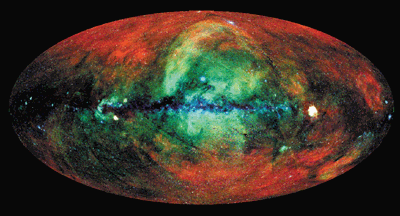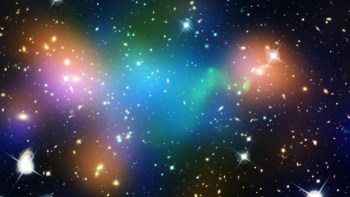Encyclopedia of Astronomy and Astrophysics
Paul Murdin (ed)
2001 Nature Publishing Group/Institute of Physics Publishing 3600pp £450/$650hb four-volume set; £150/$200 personal on-line version

It is a tribute to the dynamism of astrophysics today, and to the achievements of the past century, that Paul Murdin and his distinguished editorial board, together with over 500 contributors, many of them extremely well known astrophysicists, should find it worthwhile to embark on the massive task of creating this encyclopaedia. It is a vast achievement, occupying four volumes and 3600 pages, with 700 main articles and a slightly greater number of short entries. I am sure that Murdin is right in claiming this to be the largest single reference source in astronomy and astrophysics. The only competition would be the many volumes of the Annual Review of Astronomy and Astrophysics.
In fact, the Encyclopedia of Astronomy and Astrophysics must be one of the grandest reference works in science today. As Martin Rees writes in the foreword: “We are witnessing a crescendo of discovery in astronomy. Probes have penetrated the outer reaches of our solar system; planets have been detected in orbit around other stars; powerful telescopes have imaged galaxies so far away that their light set out ten billion years ago when they were newly formed; and precise measurements of the ‘afterglow’ of the Big Bang disclose what happened in the first few seconds of cosmic history.”
The level of the main articles is, generally, demanding and the contributors have not been afraid to use equations and technical diagrams. I would say that the natural users of this encyclopaedia will be physics undergraduates writing an astrophysics project. They will find this an absolute mine of information and many departments will be able to expand their list of project titles simply because this resource is available.
Professional astrophysicists, meanwhile, will enjoy reading about the 90% of the field that they probably do not know too much about, such is the level of modern specialization. In many subjects, where the chosen author has made a real effort to write a comprehensive review, given credit to the main workers in the field, and provided a comprehensible bibliography, the professionals will even enjoy reading about their own areas of research.
General astronomy enthusiasts – and fortunately for astronomy they are a very numerous breed – will find the encyclopaedia fascinating, provided that they have studied mathematics and physics to a reasonably advanced level.
The coverage of different fields of astrophysics is, however, far from uniform. On the Sun and solar physics, Eric Priest has steered his contributors to an overwhelming 500 pages worth of material, which is almost too much for anyone outside the field to digest. I take my hat off to Eric and his team for their efforts, but I have to say that life may be too short for me to work my way through this section.
In contrast, cosmology, which many would see as the pinnacle of 20th-century achievement in astrophysics, occupies only 100 pages. Nevertheless, many of the individual cosmological articles are excellent, for example those on topological defects in cosmology (Paul Shellard), light-element nucleosynthesis (Gary Steigman), galaxy formation (Joseph Silk and Rychard Bouwens), gravitational lensing (Prasenjit Saha), the Sunyaev-Zeldovich effect (Anthony Lasenby) and the Lyman alpha forest (Michael Rauch).
There are other cosmological articles that are also good, but their value to some readers will be reduced by the lack of a full bibliography. These include the articles on the Standard Model of particle physics (John Ellis), the cosmic microwave background (Edward Wright), the standard model of cosmology (John Peacock), simulations of structure and galaxy formation (Carlton Baugh and Carlos Frenk), dark matter (Georg Raffelt) and gravitational radiation (Bernard Schutz).
However, some of the cosmological topics are not, in my view, covered well at all, usually because the articles are not ambitious enough in their scope or because they lack adequate bibliographies. These include the articles on the Hubble diagram, the redshift, galaxies at high redshift, the universal distance scale, universal thermal history, galaxy-redshift surveys, and the Hubble deep field.
There are good articles in the area of extragalactic astrophysics on quasistellar objects – although its author, Patrick Osmer, has not included a bibliography – on elliptical galaxies (Roger Davies), supermassive black holes (Luis Ho and John Kormendy), galaxy interactions and mergers (C Mihos), Seyfert galaxies (Mark Whittle), the distribution of galaxies (although Marc Postman’s article has a poor bibliography) and on the Local Group (Mario Mateo).
Stellar astrophysics is well served by fine articles on stellar evolution and helioseismology (Jørgen Christensen-Dalsgaard), the Hertzsprung-Russell diagram (Cesare Chiosi), solar neutrinos (John Bahcall), star formation (Joan Najita), nucleosynthesis (Friedrich Thielemann), RR Lyrae stars (Allan Sandage), pulsars (Stephen Thorsett) and supernovae (Craig Wheeler).
And on the interstellar medium, I liked the articles on dusty circumstellar dust shells (Ben Zuckerman), interstellar grains (Bruce Draine), interstellar absorption lines (Edward Jenkins), the physics of molecules (David Williams), interstellar molecular clouds (Leo Blitz) and interplanetary dust (Mark Sykes). There is also good coverage of planetary physics and of the new field of extrasolar planets.
These articles, which are just a few that caught my eye among the 700, give some impression of the breadth and detail of the coverage, and of the quality of the contributors. There are also some fascinating historical articles, especially those by Noel Swerdlow (on planetary theory from Eudoxus to Copernicus), Robert Smith (on extragalactic astronomy from 1900 to 1950) and Michael Hoskin (on stellar astronomy).
However, the short biographical pieces are often inaccurate and the entry on Aristotle is, frankly, ludicrous. Aristotle’s view of the cosmos held sway for almost 2000 years and deserves to be properly described. For example, his concept of a universal time was preserved unchanged in Newtonian theory and was modified only with the advent of the special and general theories of relativity. Even then, Aristotle’s universal time re-emerges unscathed in the cosmic time of modern cosmological theory. To dismiss him, as the author does, with the remarks that “Aristotle’s model lasted for centuries. It held back the progress of science until the authority of the church was challenged by observation and experiment, as by Galileo” can only be characterized as a facile version of the history of medieval science.
Straying even further from the preoccupations of the modern astrophysicist, there are interesting reviews on exobiology and the origin of life. Paul Murdin and Patrick Moore provide a very nice entry on art and literature in astronomy. The encyclopaedia contains over 2000 illustrations, some in colour. The latter, however, are collected together in blocks and are rendered slightly less useful by the fact that you have to find the black-and-white version of the illustration in the relevant article to read the caption.
A big disappointment is the coverage of the astronomy of the new wavebands – radio, infrared, X-ray and submillimetre – and the entries on space missions. While some solar-system missions merit several pages (Rosetta, SOHO, Ulysses, Vega), major astronomical missions like IRAS, COBE, Einstein and ROSAT receive only a few sentences. The piece on the Hubble Space Telescope is particularly weak. The poor coverage of these major areas of modern astrophysics, together with the unambitious and patchy coverage of cosmology previously mentioned, represent the main weaknesses of the encyclopaedia.
Overall, though, Paul Murdin and his team of contributors are to be congratulated on a major achievement. The publishers – Nature Publishing Group and Institute of Physics Publishing – also deserve praise for this ambitious venture. One aspect of the encyclopaedia that is particularly exciting is that it is also being published as an electronic on-line version, and the editor promises that this will be revised quarterly, with 20% of the text being revised each year. This means that the weaknesses can be rapidly fixed and the encyclopaedia kept relatively up to date in this rapidly moving field.
I hope that we will soon see all the major articles providing substantial bibliographies, including relevant books and review articles as well as specialist articles. I think that most universities that offer astrophysics courses will want to subscribe to the electronic version. For individuals, the book version would be a handsome, if expensive, acquisition. If there were to be a new revised edition in a couple of years’ time, that might be the one to have on your shelves.
* Further details about the encyclopaedia, including full pricing details, are available at www.macmillan-reference.co.uk/astro/index.htm



